




DISCLOSURE LOG - FOI 23/24-0860 - DOCUMENTS
DOCUMENT 1
Evidence Summary: Art
and music therapy
Version:
4
Date:
26 November 2024
Author:
Evidence and Practice Leadership Branch
Division:
Policy, Evidence and Practice Leadership Division
The contents of this document are OFFICIAL.
1
DISCLOSURE LOG - FOI 23/24-0860 - DOCUMENTS
OFFICIAL
Executive summary
This document summarises the current evidence on art and music therapy for people
with disabilities. Evidence was generated through a rapid review focused on
functional capacity outcomes (e.g. language and communication, personal care,
mobility and movement, interpersonal interactions, functioning, and community
living) following art and music therapy delivered by a therapist (i.e. allied health
professional).
This rapid review was undertaken to inform practice considerations and guidance
related to the implementation of the S10 transitional rule, Schedule 1, and may be
used as evidence by the NDIS Evidence Advisory Committee to assist with making
recommendations made about art and music therapy.
This rapid review shows that there is some evidence which supports the use of art
and music therapy for certain disability groups (e.g. art therapy for children with
autism, music therapy for people with multiple sclerosis and people who have had a
stroke). Overall, the identified evidence was not conclusive in supporting art and
music therapy as evidence-based, therapeutic supports for all disability groups.
Considering the low risk of art and music therapy to participants and the Scheme,
the evidence generated through this rapid review is likely sufficient to understand the
state of evidence and meet current needs. Any decision regarding the need for
further evidence needs to consider the relative priority of art and music therapy
against other supports.
Evidence for art therapy
Art therapy includes the therapeutic use of art materials. The available evidence for
art therapy showed:
Some evidence for the benefit of art therapy for children with autism across a
range of outcomes (mobility and movement, interpersonal interactions, and
other outcomes such as hyperactivity and inattention).
Limited but positive indications for the benefit of art therapy across some
outcomes for adults with learning disabilities (on interpersonal interactions
and psychosocial functioning outcomes), children with cerebral palsy (on
language and communication outcomes), people with PTSD (on psychosocial
functioning outcomes), and people with anxiety and depression (on
psychosocial functioning outcomes).
Limited evidence which indicated mixed and unclear benefit for people with
eating disorders and people with non-psychotic mental disorders.
ndis.gov.au
November 2024 | Art and music therapy
2
2
OFFICIAL
DISCLOSURE LOG - FOI 23/24-0860 - DOCUMENTS
OFFICIAL
Limited evidence which indicated that art therapy may not provide any benefit
for children with learning disabilities and people with schizophrenia.
Evidence for music therapy
Music therapy is a form of therapy that uses music within a therapeutic relationship
between a client and trained professional. The available evidence for music therapy
showed:
Some evidence for the benefit of music therapy for people with multiple
sclerosis and people who have had a stroke on mobility and movement
outcomes.
Limited but positive indications for the benefit of music therapy for people
living with Parkinson’s disease (on communication, mobility and movement
and psychosocial functioning outcomes), and people with depression and
anxiety (on interpersonal interactions and psychosocial functioning
outcomes).
Limited evidence which indicated mixed and unclear benefits for people with
autism, people with schizophrenia, people with PTSD, children with epilepsy,
and children with an intellectual disability and auditory processing disorder.
ndis.gov.au
November 2024 | Art and music therapy
3
3
OFFICIAL
DISCLOSURE LOG - FOI 23/24-0860 - DOCUMENTS
OFFICIAL
Introduction
This document summarises the current evidence on art and music therapy for people
with disabilities on functional capacity outcomes, based on a NDIA rapid review
process. The evidence from this rapid review may inform practice considerations and
guidance in the short term related to the implementation of S10 transitional rule,
Schedule 1.
Schedule 1 of The National Disability Insurance Scheme (Getting the NDIS Back on
Track No. 1) (NDIS Supports) Transitional Rules 2024, as well as the participant-
facing translation document (“Supports that are NDIS supports”) lists therapeutic
supports as NDIS supports. In both the legislation and the participant-facing
translation, therapeutic supports are defined as:
Supports that provide evidence-based therapy to help participants improve or
maintain their functional capacity in areas such as language and
communication, personal care, mobility and movement, interpersonal
interactions, functioning (including psychosocial functioning) and community
living.
Art and music are not specifically listed in the Section 10 NDIS Supports lists.
However, we know that people enjoy art and music as part of community activities.
Often, these activities don’t need to be provided by a therapist. However, adding the
word “therapy” suggests that these activities provide therapeutic benefits and should
be delivered by a qualified health professional. This is in line with NDIS Pricing
Arrangements, which state that therapy supports must be provided by a therapist or
a supervised therapy assistant.
Evidence is needed to determine whether art and music therapy meet the legislative
criteria for therapeutic supports. The Evidence and Practice Leadership Branch was
asked to undertake a rapid review of the evidence to inform guidance. A rapid review
can provide decision makers with insights into the state of evidence and whether
there is an indication or not that these therapies may be beneficial.
Definitions of art therapy and music therapy
Art therapy is a form of therapy that includes the therapeutic use of art materials. It
uses the art-making process as its primary mode of communication and can
therefore be particularly helpful to people who find it hard to express their thoughts
and feelings verbally. Art therapy can sometimes be regarded as a three-way
process between the client, the therapist and the image or artefact. Art therapy may
ndis.gov.au
November 2024 | Art and music therapy
4
4
OFFICIAL
DISCLOSURE LOG - FOI 23/24-0860 - DOCUMENTS
OFFICIAL
include an individual or combination of modalities, including painting, drawing,
sculpting and modeling clay.
Music therapy is a form of therapy that uses music within a therapeutic relationship
between a client and qualified therapist to address physical, emotional, cognitive,
and social needs. Music therapy may involve a variety of different activities, including
music improvisation, music listening, song writing, music performance, learning
through music, and others.
Review questions
This rapid review aimed to answer the following questions:
1. What is the state of evidence for the impact of art therapy on functional
capacity outcomes for people with disabilities?
2. What is the state of evidence for the impact of music therapy on functional
capacity outcomes for people with disabilities?
Method
We applied our responsive rapid review methodology to answer the review questions
and provide the Agency with an overview of the state of evidence taking into
consideration the immediate need for evidence. This may inform practice
considerations and guidance in the short term related to the implementation of S10
transitional rule, Schedule 1.
Inclusion criteria for studies
We included systematic reviews or primary studies (in cases where we were unable
to locate systematic reviews) which met the following criteria:
The population was people with disabilities. Any disability group relevant to
the NDIS was eligible.
Investigated art therapy and/or music therapy (not dance therapy) which met
the following criteria:
o Delivered by a therapist
o Art or music were the focus of the intervention, not a component of a
larger intervention
ndis.gov.au
November 2024 | Art and music therapy
5
5
OFFICIAL
DISCLOSURE LOG - FOI 23/24-0860 - DOCUMENTS
OFFICIAL
o Goal was to achieve a functional outcome (e.g. language and
communication, personal care, mobility and movement, interpersonal
interactions, functioning, and community living)
Search strategy
To identify relevant studies, we used a range of methods:
1. Key words and subject headings were searched through a research database
(PubMed). This included the subject headings, “Art Therapy” and “Music
Therapy” in combination with the subject heading for systematic reviews. It
also included targeted searches for primary research in different disability
groups, with key words and subject headings for disability searched.
2. We searched for the term "Disability” in the archives of the International
Journal of Art Therapy (the official journal of the British Association of Art
Therapists)
3. We also undertook a snowballing method which involves checking identified
studies for other relevant studies.
Searches were limited to the last 10 years.
Evidence for art therapy
A range of systematic reviews and primary studies reporting evidence for art therapy
were identified. The overall quality of the evidence was variable and was not formally
assessed. Studies included people with autism, learning disabilities, cerebral palsy,
PTSD, schizophrenia, anxiety, depression, eating disorders, and non-psychotic
mental disorders.
Table 1 includes a summary of the available evidence for art
therapy by disability group and functional capacity outcomes (grouped into areas
described in the legislation). No studies reported personal care or community living
outcomes.
Overall, there is mixed and limited evidence for art therapy for people with
disabilities. Therefore, there is not enough evidence to indicate a benefit for art
therapy across all disability groups.
It is also important to note that art therapy approaches within included studies varied
across several factors, including:
Modality (e.g. painting, sculpting, molding clay, or a combination of modalities)
Length (duration and intensity of intervention)
ndis.gov.au
November 2024 | Art and music therapy
6
6
OFFICIAL
DISCLOSURE LOG - FOI 23/24-0860 - DOCUMENTS
OFFICIAL
Group or individual delivery
Setting, including country (each country has their own understanding of art
that is relevant to their local context)
The potential impact of these factors on outcomes was unable to be investigated due
to limited evidence and time constraints.
Reasonable evidence for benefit
For some disability groups, there is reasonable evidence for the benefit of art therapy
on functional outcomes.
For
children with autism, benefits of art therapy have been demonstrated
across a range of outcomes (mobility and movement, interpersonal
interactions, and other outcomes such as hyperactivity and inattention). There
are also some indications of benefit for language and communication.
Limited evidence with some positive indications
For some disability groups, there was very limited evidence for the impact of art
therapy on functional outcomes, but the available evidence provided some initial
positive indications.
For
adults with learning disabilities, a small pilot study showed some
benefit to social anxiety, wellbeing, quality of life and resilience. Evidence for
other functional capacity outcomes were not reported. This is a positive
indication, but more evidence is needed to demonstrate the effectiveness of
art therapy for this group.
For
children with cerebral palsy, one study showed improvement in
language and communication outcomes. Evidence for other functional
outcomes were not reported. This is a positive indication, but more evidence
is needed to demonstrate the effectiveness of art therapy for this group.
For
people
with
post-traumatic stress disorder (PTSD), there was some
evidence for benefit above a control group on positive non-PTSD-specific
outcomes (e.g. quality of life), but inconclusive evidence for other outcomes
(e.g. depression and intrusions). Evidence for other functional capacity
outcomes were not reported. More evidence is needed to demonstrate the
effectiveness of art therapy for this group.
For
people
with
anxiety and
depression, there was some evidence for the
benefit of art therapy above a control group on general functioning and
wellbeing, and mental health outcomes. Evidence for other functional capacity
ndis.gov.au
November 2024 | Art and music therapy
7
7
OFFICIAL
DISCLOSURE LOG - FOI 23/24-0860 - DOCUMENTS
OFFICIAL
outcomes were not reported. More evidence is needed to demonstrate the
effectiveness of art therapy for this group.
Limited and mixed evidence
For some disability groups, there was limited and mixed evidence for the impact of
art therapy on functional outcomes.
For
people
with
eating disorders, there was evidence for benefit on some
psychopathological and emotional outcomes, but no difference in others.
Evidence for other functional capacity outcomes were not reported. More
evidence is needed to determine the effectiveness of art therapy for this
group.
For
people
with
non-psychotic mental disorders, there was evidence for
some mental health outcomes, but not all. One study also showed no
difference between art therapy and a control group. Evidence for other
functional capacity outcomes were not reported. More evidence is needed to
determine the effectiveness of art therapy for this group.
Limited evidence indicating no added benefit
For some disability groups, there was limited evidence, but some indication that art
therapy may not provide added benefit for functional outcomes.
For
children with learning disabilities, no difference in interpersonal
interactions and other outcomes (self-concept, coherence) were seen
compared to a control group. However, there was very limited information
available. No studies reported language and communication, mobility and
movement, or functioning outcomes. This means we do not have information
on the impact of art therapy on these outcomes.
For
people
with
schizophrenia, little or no benefit of art therapy compared to
standard care was demonstrated for interpersonal interactions, mental health,
and global functioning. There were mixed results for negative symptoms, with
one study reporting a significant reduction and one reporting no benefit above
standard care. There was limited evidence, with only a few primary studies
investigating the impact on schizophrenia.
No available evidence
In other disability groups, we were unable to identify any evidence to understand
how art therapy impacts functional capacity. This includes all disability groups not
ndis.gov.au
November 2024 | Art and music therapy
8
8
OFFICIAL
DISCLOSURE LOG - FOI 23/24-0860 - DOCUMENTS
OFFICIAL
already mentioned. This means there might be benefits or they may not be, but we
do not have any evidence to understand this.
ndis.gov.au
November 2024 | Art and music therapy
9
9
OFFICIAL
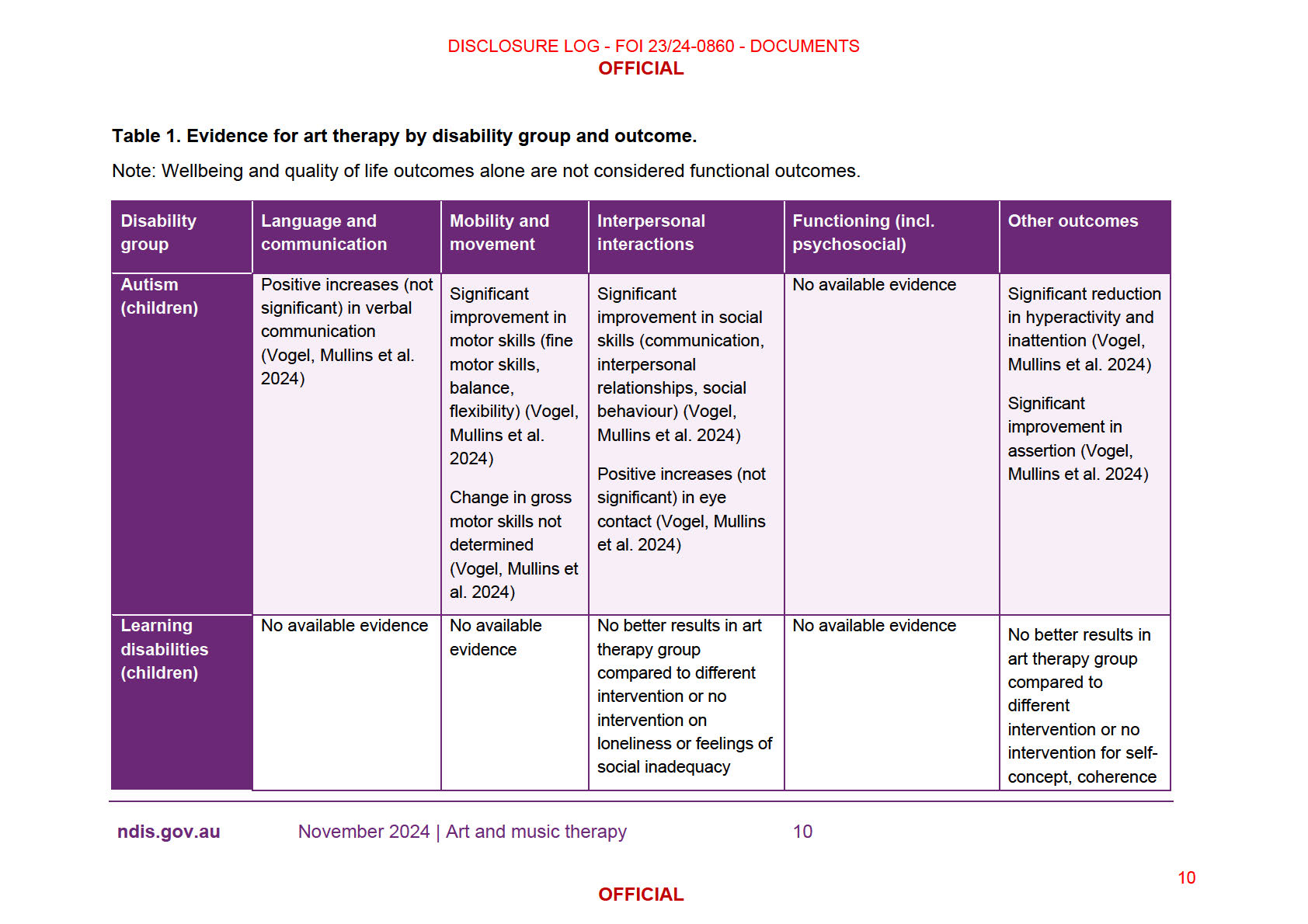

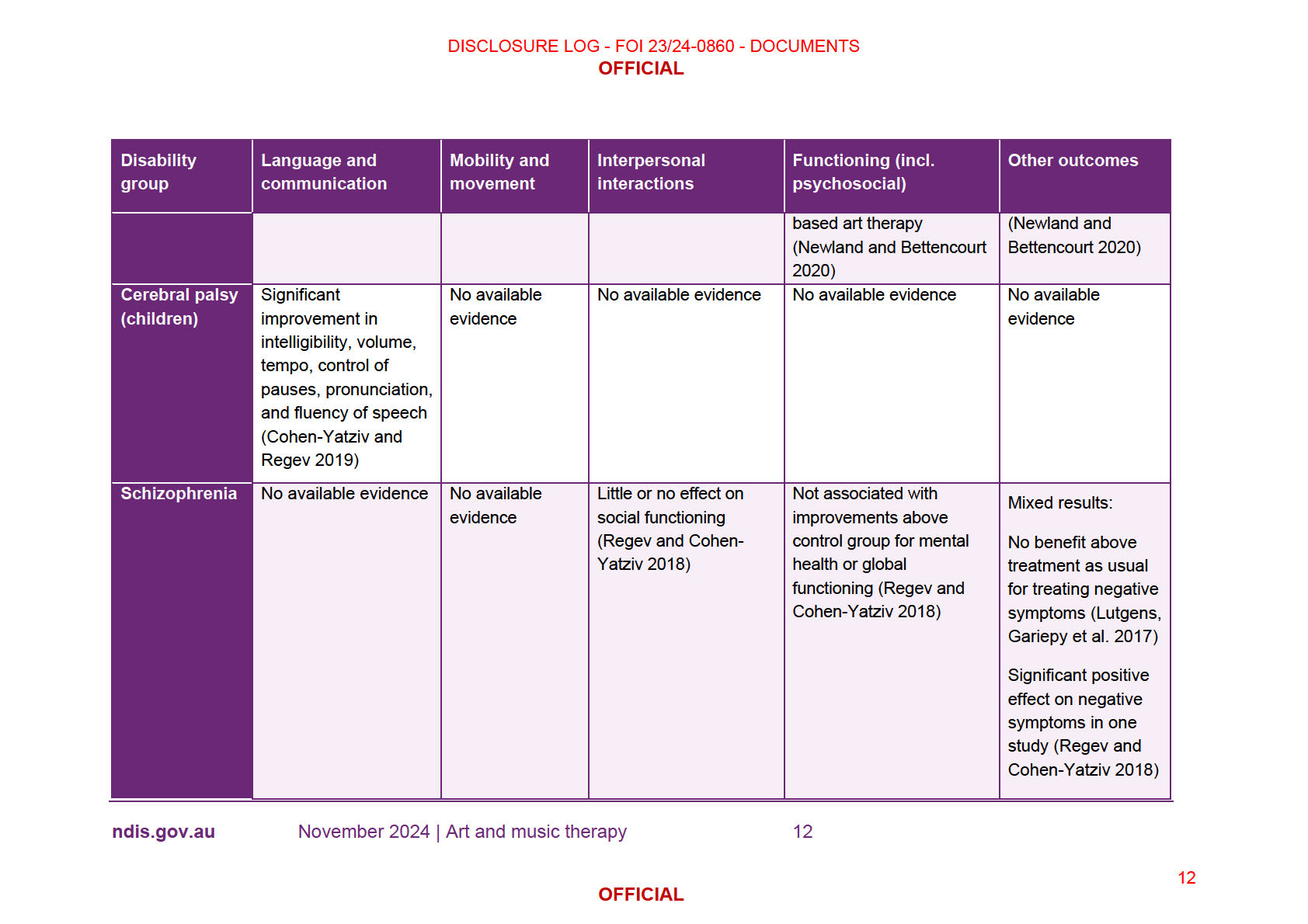
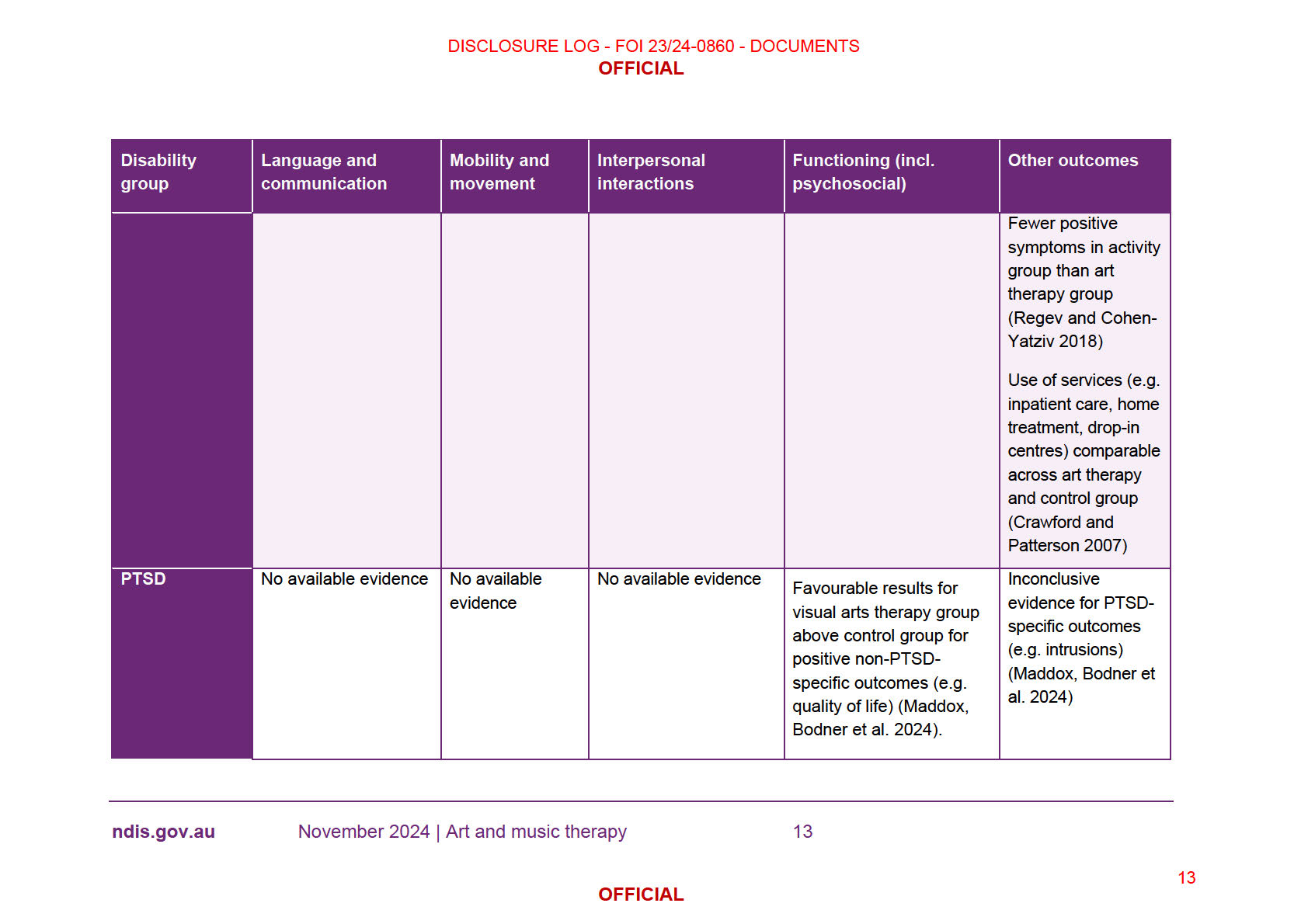
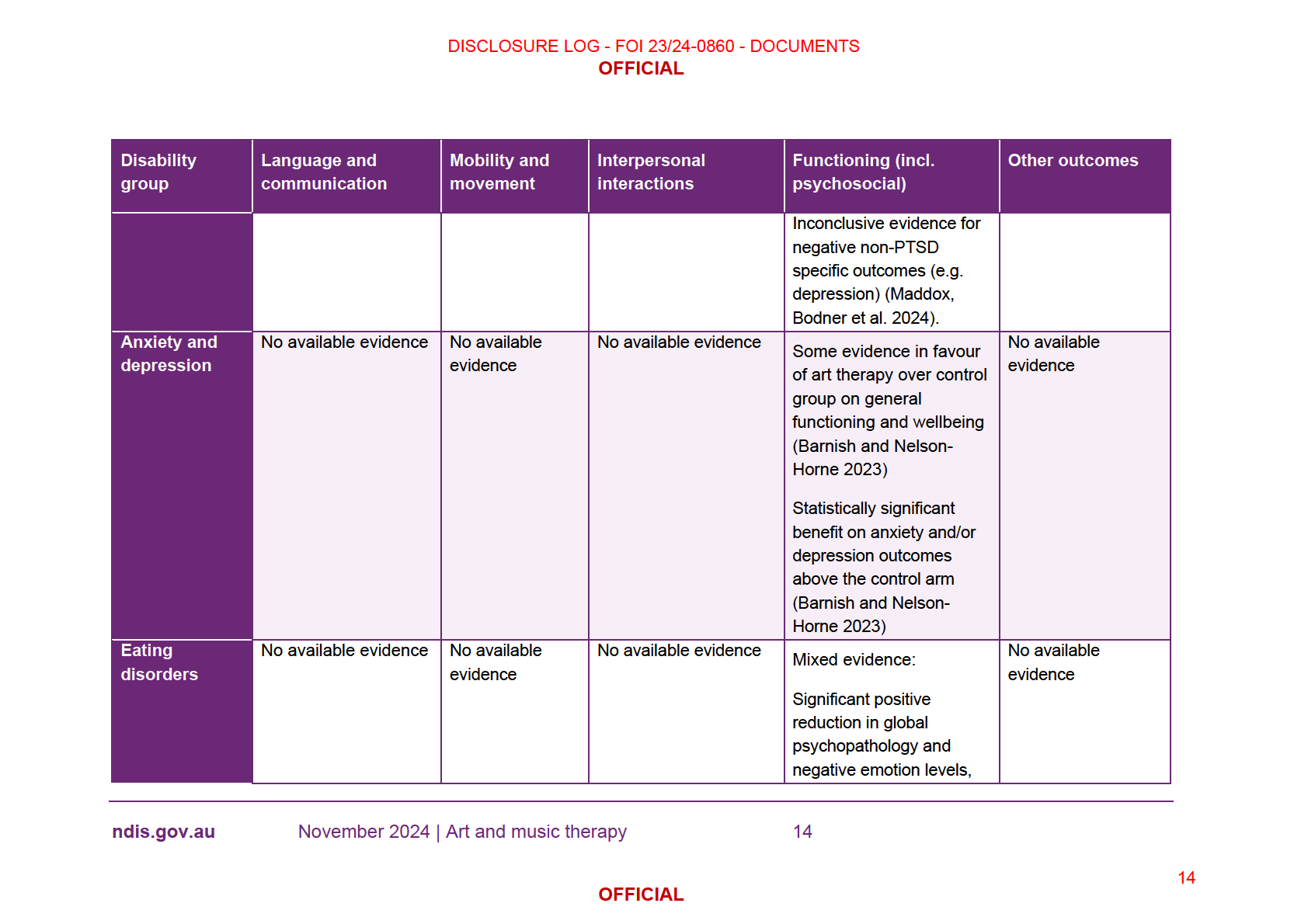
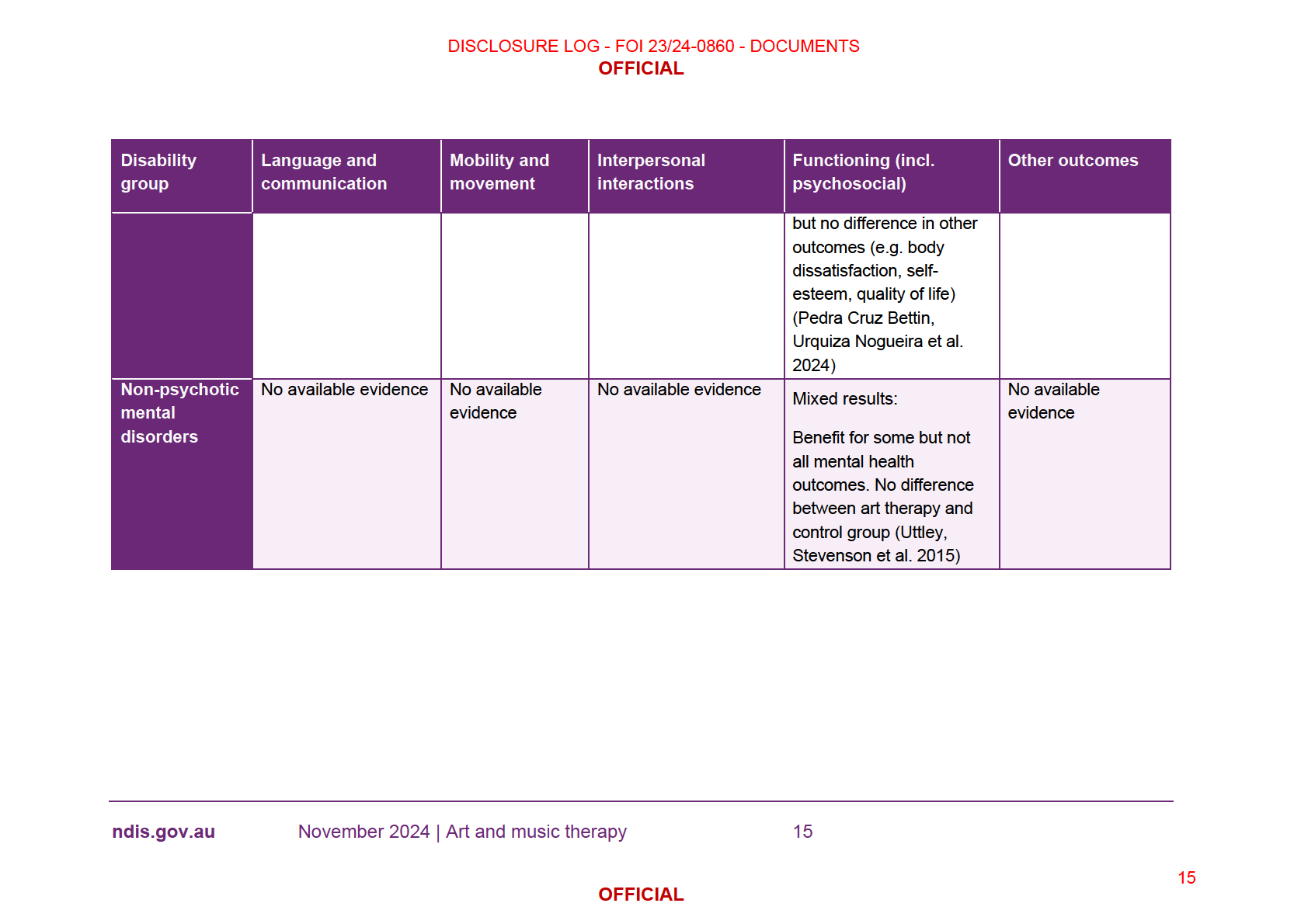
DISCLOSURE LOG - FOI 23/24-0860 - DOCUMENTS
OFFICIAL
Evidence for music therapy
Systematic reviews and primary studies reporting evidence for music therapy were
identified. The overall quality of the evidence was variable and was not formally
assessed. Studies included people with neurodevelopmental disorders (autism
spectrum disorder and intellectual disability), neurological disabilities (Parkinson’s
disease, multiple sclerosis and stroke), neurodevelopmental disease (cerebral palsy)
and mental health (PTSD, schizophrenia, anxiety and depression).
Table 2 includes
a summary of the available evidence for music therapy by disability group and
functional capacity outcomes (grouped into areas described in the legislation). No
studies reported personal care or community living outcomes.
There is mixed and limited evidence for music therapy for people with disabilities.
The evidence for music and art therapy differs by disability group. Therefore, it is
important to look at the evidence for each disability group individually.
It is also important to note that music therapy approaches within included studies
varied across several factors, including:
Modality (e.g. educational music therapy, improvisational music therapy,
family-centered music therapy, rhythmic auditory stimulation, music-based
movement therapy, listening to music, playing an instrument, singing, writing
songs, music imagery, Chinese ‘5-elements music’ therapy, Orff therapy, etc.)
Intensity (length, frequency and duration of the intervention)
Group or individual delivery
Setting, including country
The potential impact of these factors on outcomes was unable to be investigated due
to limited evidence and time constraints.
Reasonable evidence for benefit
For some disability groups, there is reasonable evidence for the benefit of music
therapy on functional outcomes.
For
people
with
multiple sclerosis (MS) there is evidence from several
studies that music therapy may be a safe and effective complementary
approach for rehabilitation of MS patients. Music therapy can improve some
aspects of gait and walking, fatigue level, fatigability, coordination, dexterity,
balance, walking endurance, lower extremity functional strength, emotional
status and pain. There is some evidence that music therapy may improve
ndis.gov.au
November 2024 | Art and music therapy
16
16
OFFICIAL
DISCLOSURE LOG - FOI 23/24-0860 - DOCUMENTS
OFFICIAL
depression, self-acceptance and quality of life in people living with MS. The
evidence for cognitive improvement, mental fatigability and memory is
unclear.
For people who have had a
stroke there is evidence that music therapy may
assist in rehabilitation. There is evidence for improvements in physical status
(upper-limb activity, various aspects of walking - such as stride length, gait
velocity and balance), cognition (paying attention, communication), and mood
in people who have had a stroke. There is evidence for the beneficial effects
of rhythmic auditory cueing on walking velocity, cadence and stride length.
Receptive music therapy may assist mood and some aspects of cognitive
function (i.e. verbal memory, focused attention). There is some evidence
‘Five-Element music’ therapy may have moderate benefit in language
rehabilitation for people with post-stroke aphasia (such as improvements in
functional communication, repetition and naming, but not comprehension).
Limited evidence with some positive indications
For some disability groups, there was very limited evidence for the impact of music
therapy on functional outcomes, but the available evidence provided some initial
positive indications.
For
people
with
Parkinson’s Disease (PD) there is some limited evidence
that rhythmic auditory stimulation may significantly improve gait speed and
stride length. However, the quality of evidence was low, and the number of
studies and participants was small. There is some evidence that music-based
movement therapy may improve motor function, balance, freezing of gait,
walking speed and mental health, but not gait cadence, stride length, or
quality of life in people with PD. There is some evidence that singing may
have a beneficial effect on speech in people with PD.
For
people
with
depression and/or
anxiety there is some evidence that
music therapy in addition to usual treatment may improve depressive
symptoms when compared with usual treatment alone. There is evidence that
music therapy in adults, adolescents and children with depression improved
symptoms of depression and improved functioning compared with usual
treatment alone. Music therapy also decreased anxiety symptoms and
cognitive ability, although showed no improvement in quality of life.
ndis.gov.au
November 2024 | Art and music therapy
17
17
OFFICIAL
DISCLOSURE LOG - FOI 23/24-0860 - DOCUMENTS
OFFICIAL
Limited and mixed evidence
For some disability groups, there was limited and mixed evidence for the impact of
music therapy on functional outcomes.
For
children and adolescents with autism it is uncertain whether music
therapy has any benefit. Music therapy has been attributed to likely or
probable improvements across a range of autism outcomes (including global
improvement, symptom severity, quality of life, speech production, social
engagement, joint attention and social functioning). There is conflicting
evidence for verbal and non-verbal communication and no evidence for social
interaction. No reduction in a measure of autism symptom severity was
observed in children from short-term (6 months) exposure to improvisational
music therapy. Mothers with children on the autism spectrum who were
followed up four years after completing a 16-week home-based family-centred
music therapy program reported long-term program benefits leading to
improved social relationships in the family and quality of life. For
(predominantly younger)
adults with autism without intellectual impairment,
music therapy may have a positive impact on mental health and wellbeing.
For
people
with
schizophrenia there is moderate to low quality evidence for
the short- to long-term effects of music therapy on global mental state
(including general and negative symptoms), general and social functioning,
and quality of life. Positive results may be mediated by the intensity
(frequency) of the intervention. There are mixed results for cognitive
functioning and inconclusive data on behavioural outcomes.
For
people
with
post-traumatic stress disorder (PTSD) there is low certainty
of the evidence for music therapy in reducing moderate to severe PTSD and
depressive symptoms.
For
children with epilepsy there is inconclusive evidence to determine the
effectiveness of listening to Mozart’s music (the ‘Mozart effect’) to reduce
seizures in children (and EEG abnormalities associated with increased
seizure risk) either as an adjunct to medical management or in children with
epilepsy refractory to medications.
For
children with intellectual disability and auditory processing disorder,
Orff music therapy (a developmental approach to music therapy) was found to
significantly improve auditory processing skills.
No available evidence
In other disability groups, we were unable to identify any evidence to understand
how music therapy impacts functional capacity. This includes all disability groups not
ndis.gov.au
November 2024 | Art and music therapy
18
18
OFFICIAL
DISCLOSURE LOG - FOI 23/24-0860 - DOCUMENTS
OFFICIAL
mentioned. This means there might be benefits or they may not be, but we do not
have any evidence to understand this.
ndis.gov.au
November 2024 | Art and music therapy
19
19
OFFICIAL
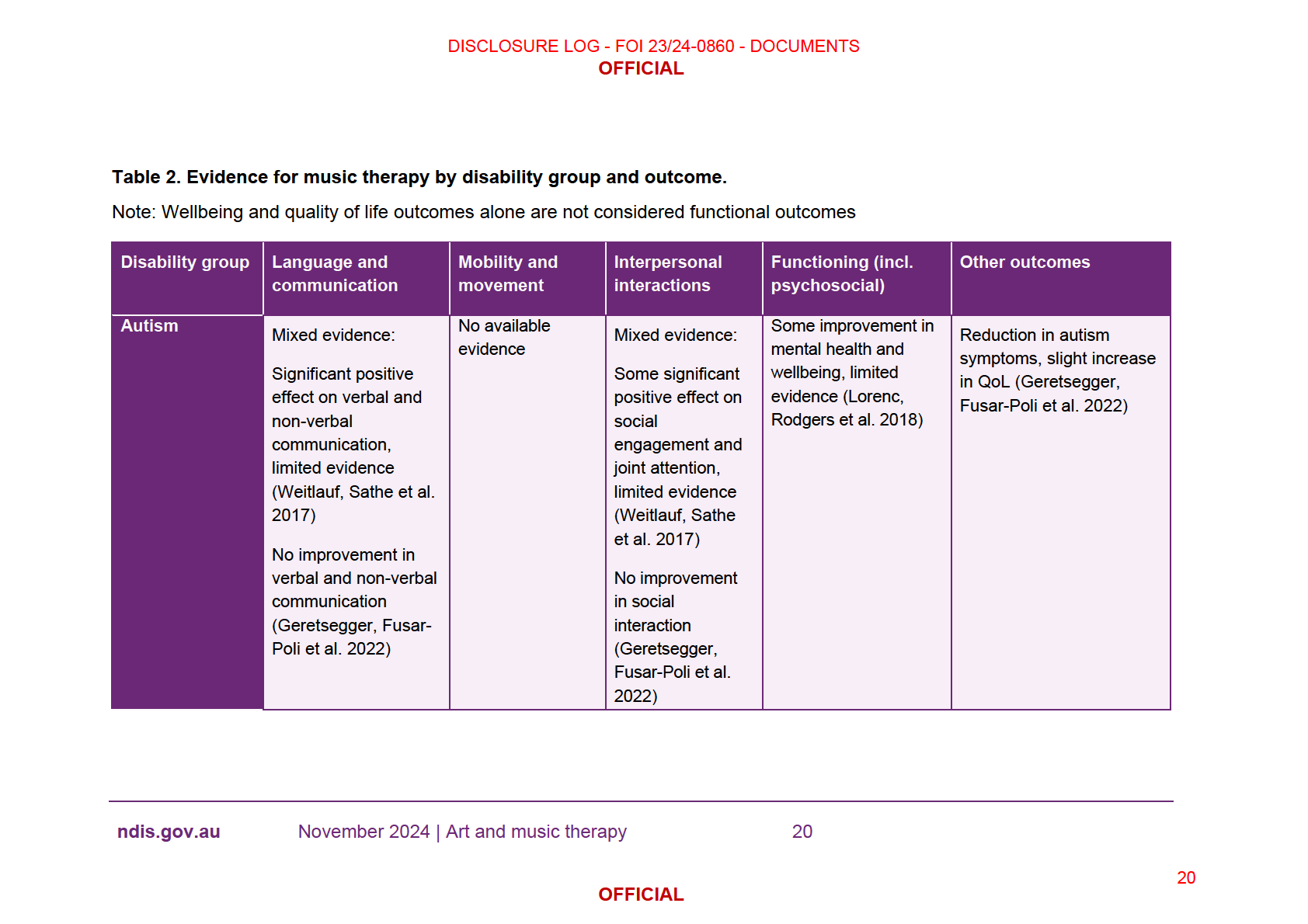
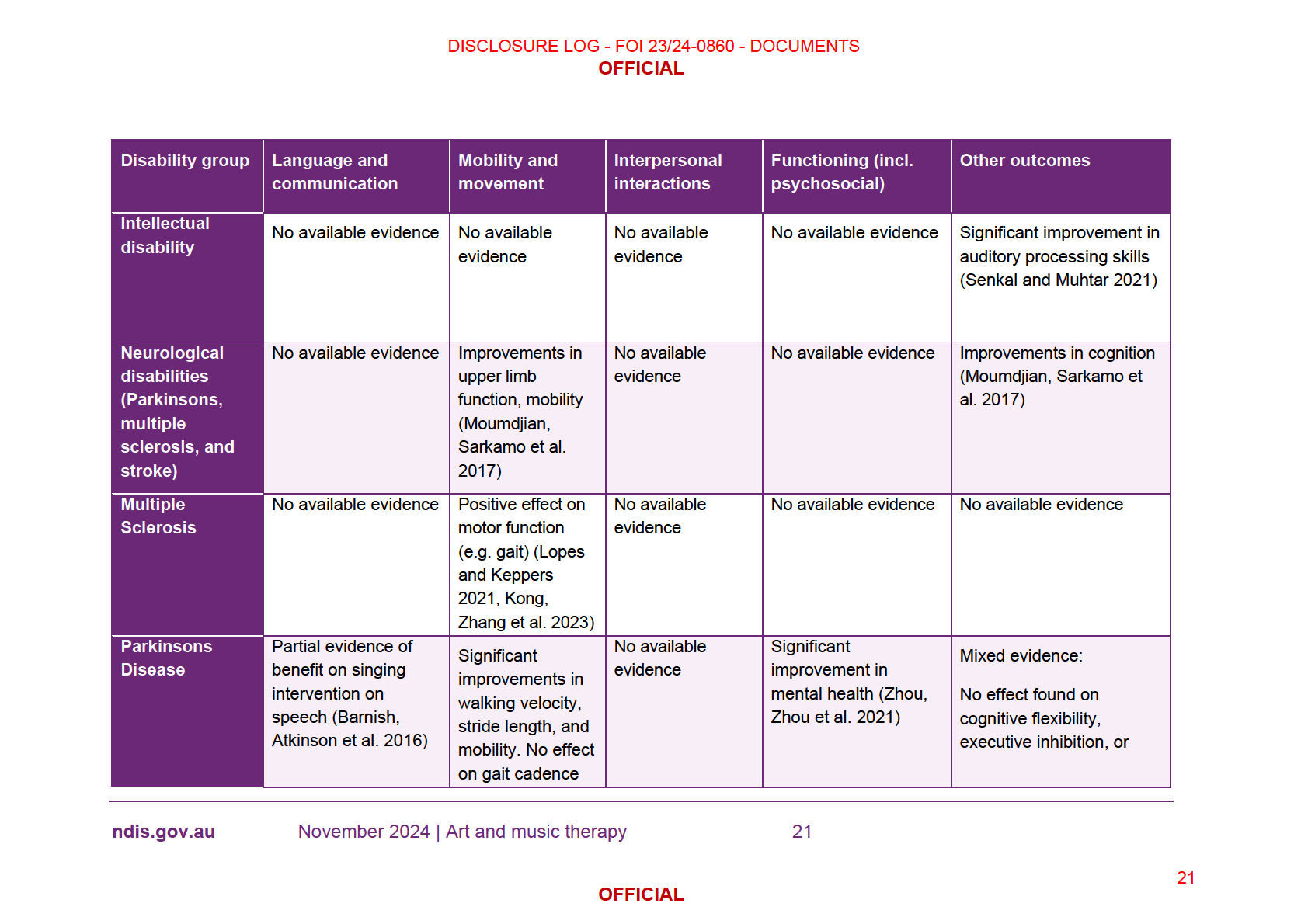
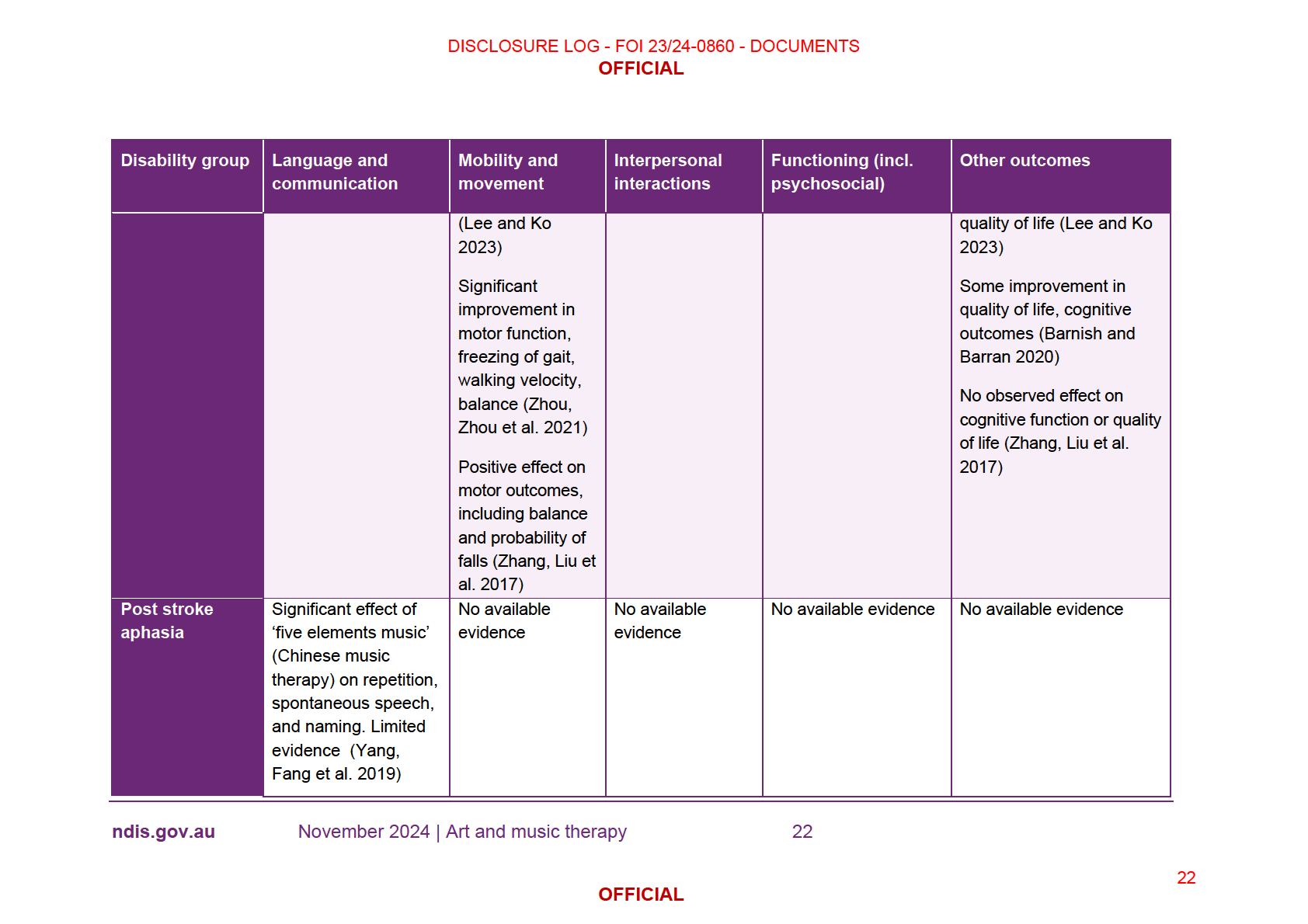
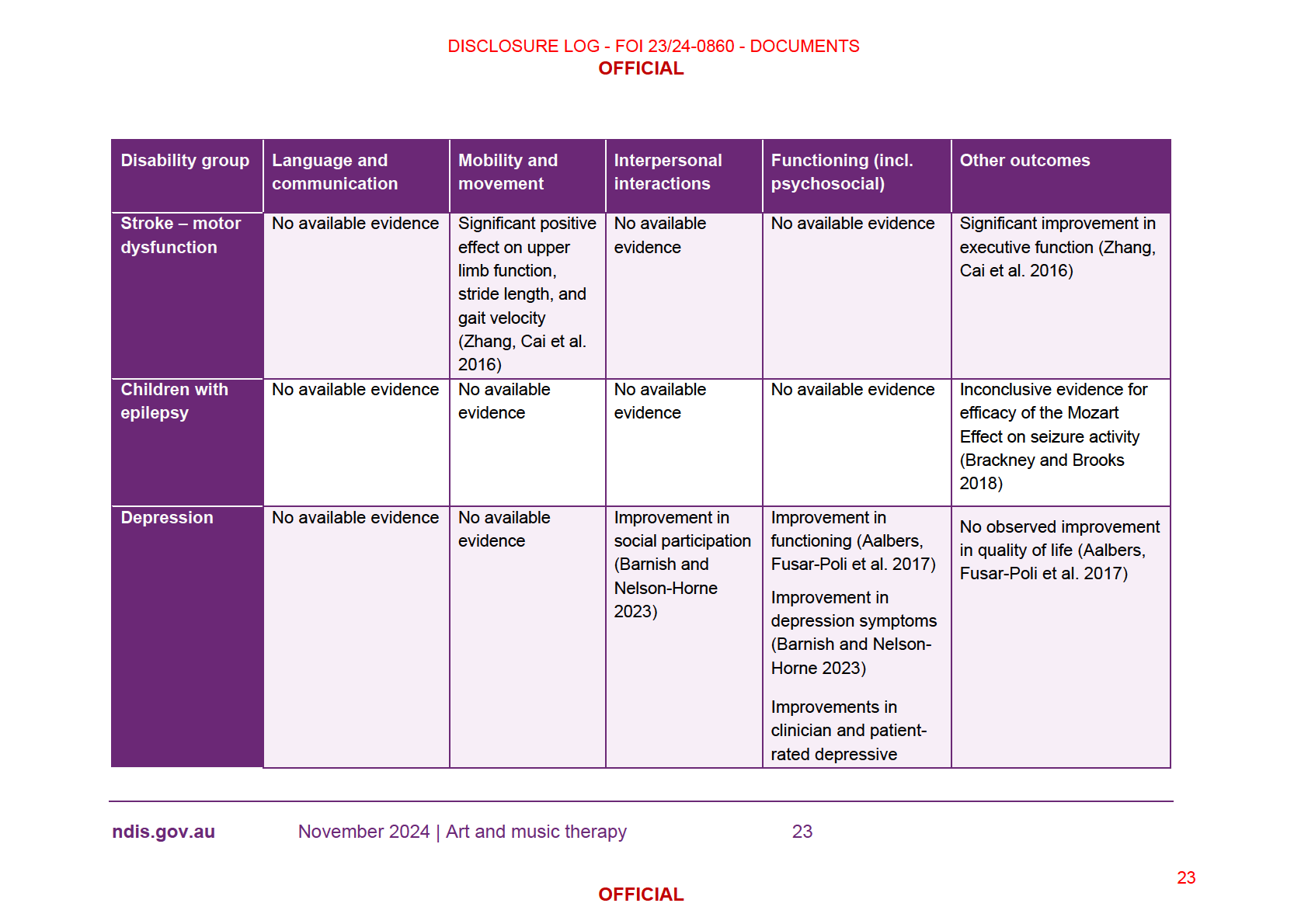
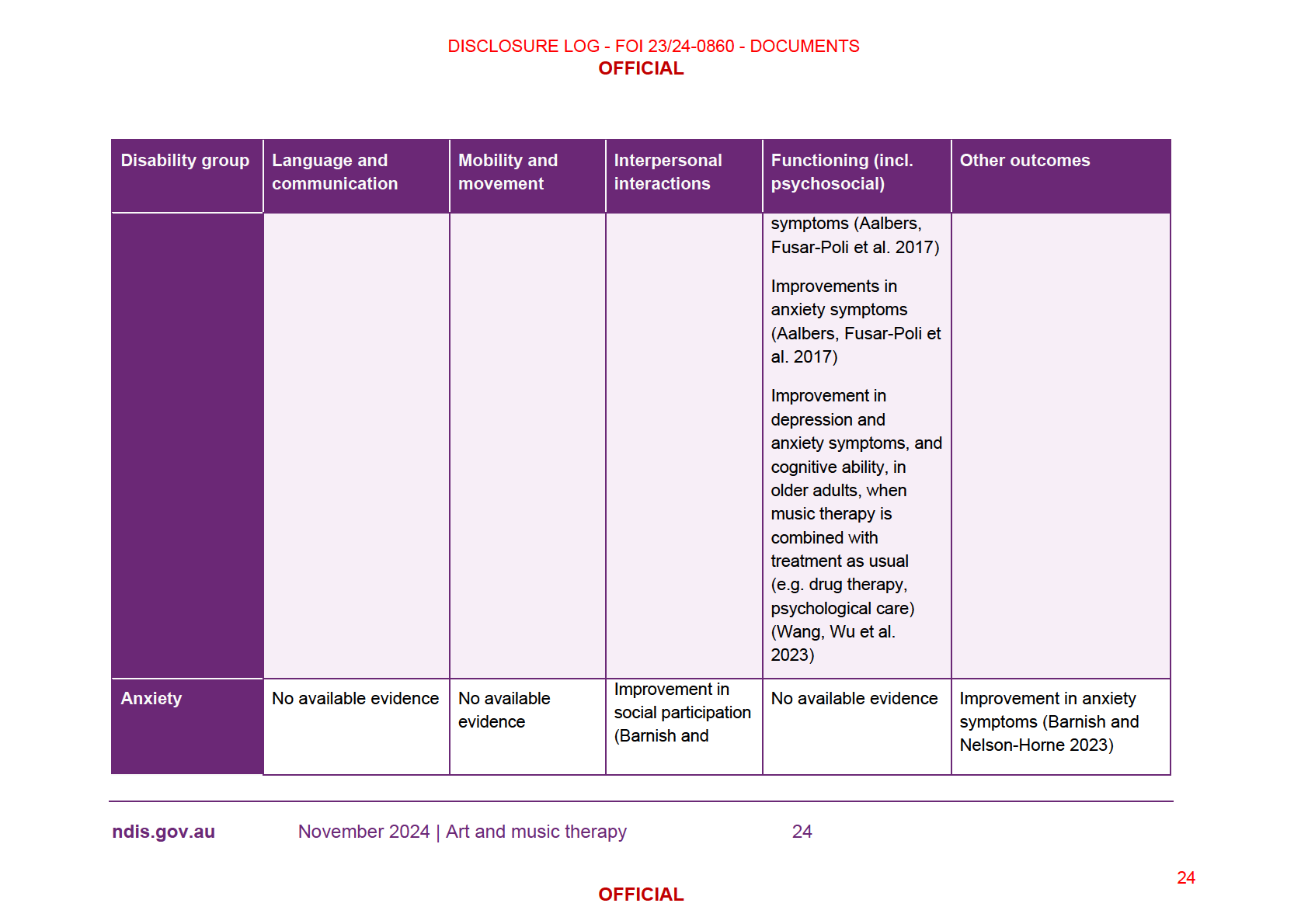
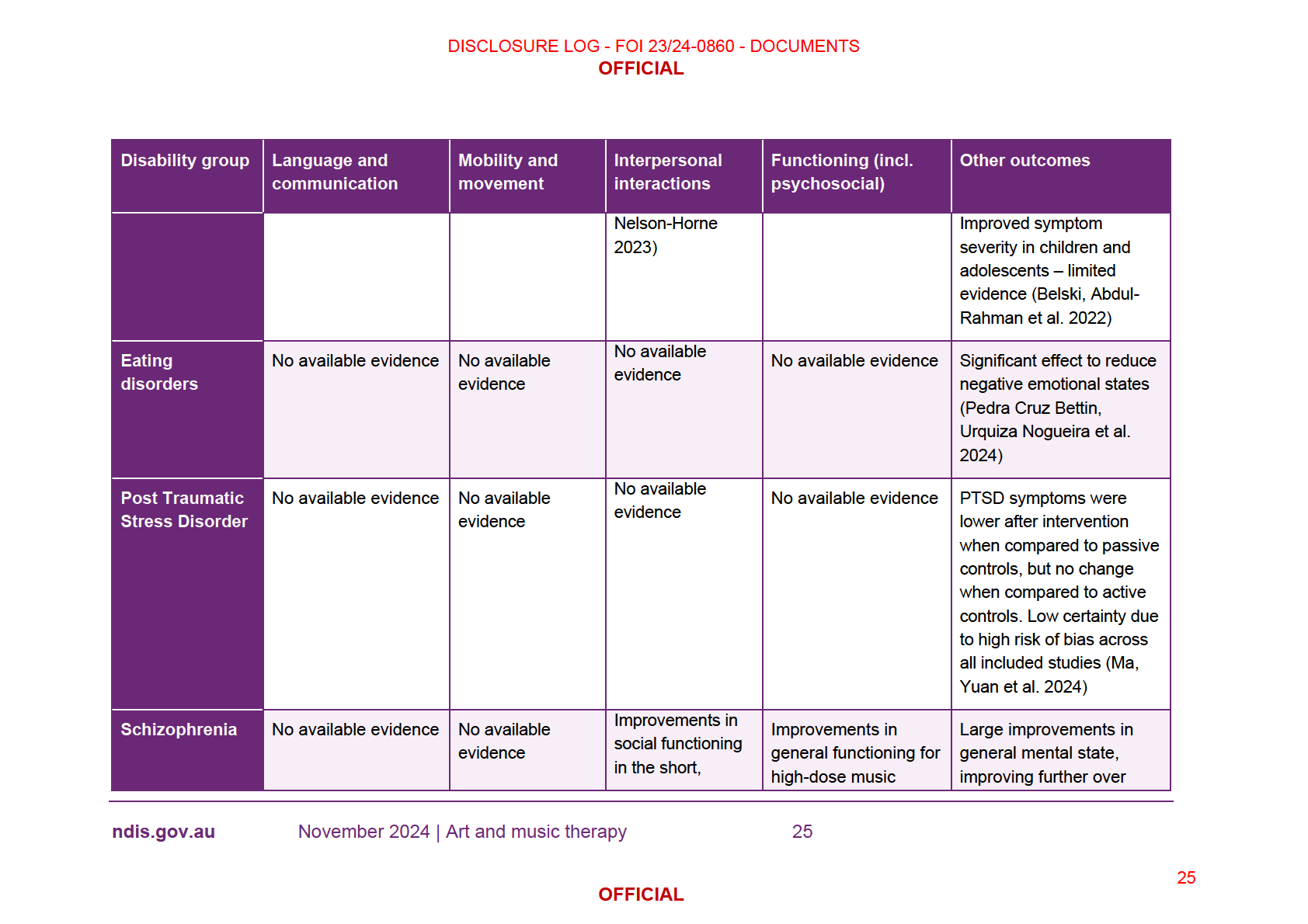
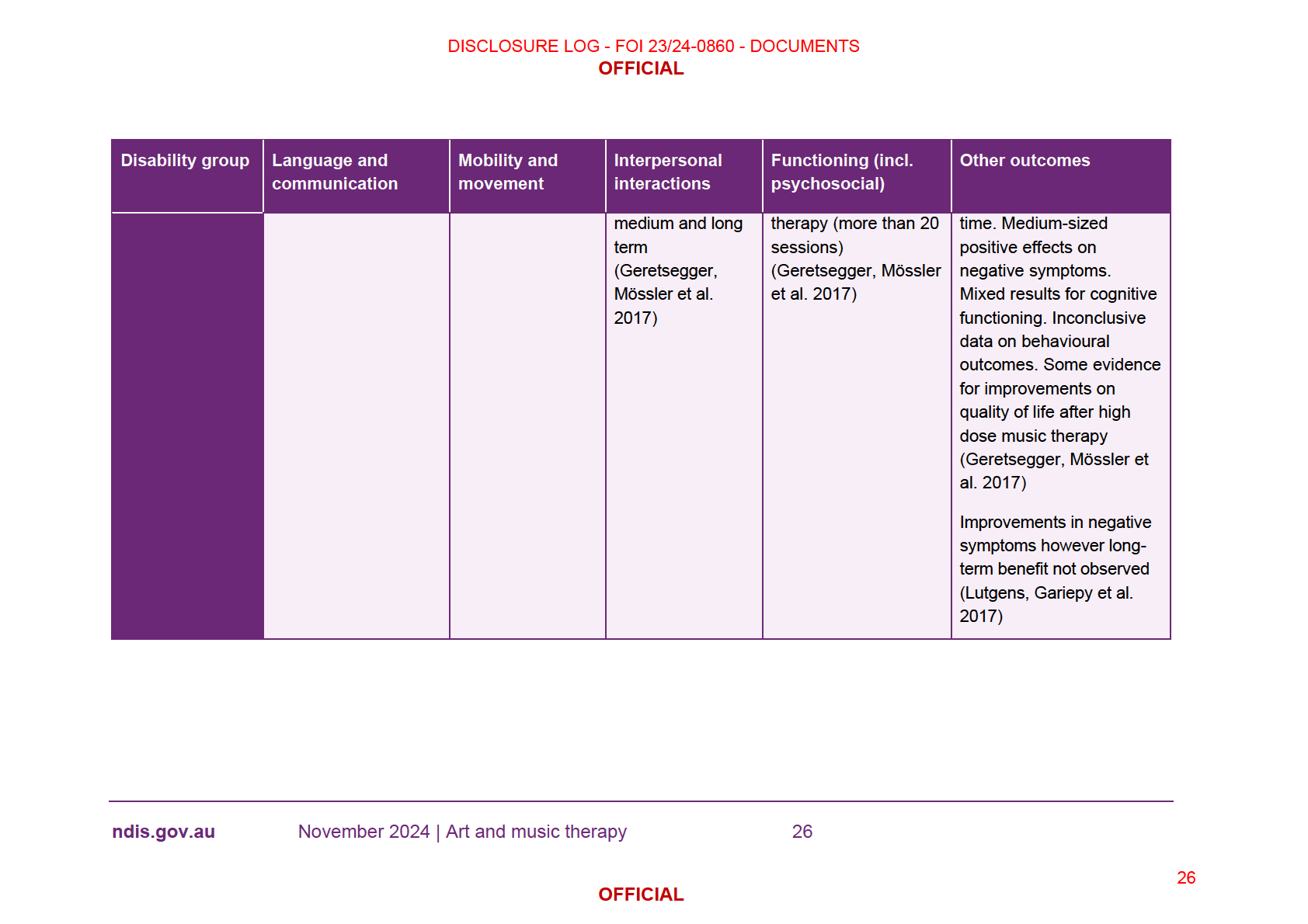
DISCLOSURE LOG - FOI 23/24-0860 - DOCUMENTS
OFFICIAL
Summary
We applied a rapid review process to investigate the impact of art and music therapy
delivered by an allied health professional on functional outcomes for people with
disabilities. There is evidence for the benefit of art and music therapy for some
disability groups. However, there is not enough evidence to indicate whether there is
a benefit across all disability groups. Additionally, for some disability groups, there is
evidence which indicates no added benefit of art and music therapy above a control
group.
The available evidence for art therapy showed:
Some evidence for the benefit of art therapy for children with autism.
Limited evidence but positive indications for the benefit of art therapy across
some outcomes for adults with learning disabilities, children with cerebral
palsy, people with PTSD, and people with anxiety and depression.
Limited evidence with mixed indications for the benefit of art therapy for
people with eating disorders and people with non-psychotic mental disorders.
Limited evidence with some indication that art therapy may not provide added
benefit for children with learning disabilities and people with schizophrenia.
The available evidence for music therapy showed:
Some evidence for the benefit of music therapy for people with multiple
sclerosis and people who have had a stroke.
Limited evidence but positive indications for the benefit of music therapy
across some outcomes for people living with Parkinson’s disease, and people
with depression and/or anxiety.
Limited evidence with mixed indications for the benefit of music therapy for
people with autism, people with schizophrenia, people with PTSD, children
with epilepsy, and children with an intellectual disability and auditory
processing disorder.
It is likely that the evidence generated through this rapid review meets the level of
evidence required for art and music therapy as low risk and relatively low value
supports. A more rigorous and time-intensive review may be excessive considering
these factors and may reach the same conclusions as this rapid review. As such, this
rapid review could be used as evidence tabled at the NDIS Evidence Advisory
Committee to assist with making recommendations made about art and music
therapy.
ndis.gov.au
November 2024 | Art and music therapy
27
27
OFFICIAL
DISCLOSURE LOG - FOI 23/24-0860 - DOCUMENTS
OFFICIAL
Any need for further evidence would need to be determined with an assessment of
the relative priority and opportunity cost of investigating art and music therapy in the
short term compared to other higher risk therapies and high-cost assistive
technology. If a need for further evidence is identified, a systematic review could be
undertaken. A standard systematic review can take 4-8 months.
Limitations
Research spanning the broad range of disability groups relevant to the NDIS was
greatly limited, with studies only available for certain disability groups. Some studies
may have been missed, considering limited timeframes, or more primary research
may be needed to fill these evidence gaps. Where studies on relevant populations
were identified, the breadth of functional capacity outcomes relevant to the NDIS
were also rarely measured. While functional outcomes were not often measured, it is
important to note the link between improved mental health and wellbeing and
increased functional capacity, especially for people with psychosocial disability.
It is also important to note that while rapid reviews are useful when evidence is
needed quickly, a rapid review cannot:
Definitively
answer
questions
of efficacy or effectiveness
Identify all the literature associated with a review question
Include all the relevant studies or all the information contained in the studies
Appraise the quality of the studies.
This means that a rapid review cannot assess how reliable the evidence is, and how
confident we can be in any observed effects. A rapid review can only show some of
the evidence that is available, and what that evidence says in broad terms. This
method is useful when evidence is needed quickly to inform interim guidance, in
cases where the risk to the participant and the Scheme is likely to be low.
However, it is important to note that this type of research is not robust enough to be
considered adequate for high level decision-making, and in cases where supports
have a high associated cost or a risk of harm to participants. In these instances, a
more robust approach to evidence is needed. This could look like a systematic
review.
ndis.gov.au
November 2024 | Art and music therapy
28
28
OFFICIAL
DISCLOSURE LOG - FOI 23/24-0860 - DOCUMENTS
OFFICIAL
References
1. Aalbers, S., L. Fusar-Poli, R. E. Freeman, M. Spreen, J. C. Ket, A. C. Vink, A.
Maratos, M. Crawford, X. J. Chen and C. Gold (2017). "Music therapy for
depression." Cochrane Database Syst Rev
11(11): Cd004517.
2. Barnish, J., R. A. Atkinson, S. M. Barran and M. S. Barnish (2016). "Potential
Benefit of Singing for People with Parkinson's Disease: A Systematic
Review." J Parkinsons Dis
6(3): 473-484.
3. Barnish, M. S. and S. M. Barran (2020). "A systematic review of active group-
based dance, singing, music therapy and theatrical interventions for quality of
life, functional communication, speech, motor function and cognitive status in
people with Parkinson's disease." BMC Neurol
20(1): 371.
4. Barnish, M. S. and R. V. Nelson-Horne (2023). "Group-based active artistic
interventions for adults with primary anxiety and depression: a systematic
review." BMJ Open
13(6): e069310.
5. Belski, N., Z. Abdul-Rahman, E. Youn, V. Balasundaram and D. Diep (2022).
"Review: The effectiveness of musical therapy in improving depression and
anxiety symptoms among children and adolescents - a systematic review."
Child Adolesc Ment Health
27(4): 369-377.
6. Brackney, D. E. and J. L. Brooks (2018). "Complementary and Alternative
Medicine: The Mozart Effect on Childhood Epilepsy—A Systematic Review."
The Journal of school nursing
34(1): 28-37.
7. Cohen-Yatziv, L. and D. Regev (2019). "The effectiveness and contribution of
art therapy work with children in 2018 -what progress has been made so far?
A systematic review." International Journal of Art Therapy
24(3): 100-112.
8. Crawford, M. J. and S. Patterson (2007). "Arts therapies for people with
schizophrenia: an emerging evidence base."
10: 69-70.
9. Geretsegger, M., L. Fusar-Poli, C. Elefant, K. A. Mössler, G. Vitale and C.
Gold (2022). "Music therapy for autistic people." Cochrane Database Syst
Rev
5(5): Cd004381.
10. Geretsegger, M., K. A. Mössler, Ł. Bieleninik, X. J. Chen, T. O. Heldal and C.
Gold (2017). "Music therapy for people with schizophrenia and schizophrenia-
like disorders." Cochrane Database Syst Rev
5(5): Cd004025.
11. Kong, L., X. Zhang, L. Meng, H. Xue, W. Zhou, X. Meng, Q. Zhang and J.
Shen (2023). "Effects of music therapy intervention on gait disorders in
persons with multiple sclerosis: A systematic review of clinical trials." Mult
Scler Relat Disord
73: 104629.
12. Lee, H. and B. Ko (2023). "Effects of Music-Based Interventions on Motor and
Non-Motor Symptoms in Patients with Parkinson's Disease: A Systematic
Review and Meta-Analysis." Int J Environ Res Public Health
20(2).
13. Lopes, J. and Keppers, II (2021). "Music-based therapy in rehabilitation of
people with multiple sclerosis: a systematic review of clinical trials." Arq
Neuropsiquiatr
79(6): 527-535.
14. Lorenc, T., M. Rodgers, D. Marshall, H. Melton, R. Rees, K. Wright and A.
Sowden (2018). "Support for adults with autism spectrum disorder without
intellectual impairment: Systematic review." Autism
22(6): 654-668.
ndis.gov.au
November 2024 | Art and music therapy
29
29
OFFICIAL
DISCLOSURE LOG - FOI 23/24-0860 - DOCUMENTS
OFFICIAL
15. Lutgens, D., G. Gariepy and A. Malla (2017). "Psychological and psychosocial
interventions for negative symptoms in psychosis: systematic review and
meta-analysis." Br J Psychiatry
210(5): 324-332.
16. Ma, Y. M., M. D. Yuan and B. L. Zhong (2024). "Efficacy and acceptability of
music therapy for post-traumatic stress disorder: a systematic review and
meta-analysis of randomized controlled trials." Eur J Psychotraumatol
15(1):
2342739.
17. Maddox, G. A., G. E. Bodner, M. W. Christian and P. Williamson (2024). "On
the Effectiveness of Visual Arts Therapy for Traumatic Experiences: A
Systematic Review and Meta-Analysis." Clin Psychol Psychother
31(4):
e3041.
18. Moumdjian, L., T. Sarkamo, C. Leone, M. Leman and P. Feys (2017).
"Effectiveness of music-based interventions on motricity or cognitive
functioning in neurological populations: a systematic review." Eur J Phys
Rehabil Med
53(3): 466-482.
19. Newland, P. and B. A. Bettencourt (2020). "Effectiveness of mindfulness-
based art therapy for symptoms of anxiety, depression, and fatigue: A
systematic review and meta-analysis." Complement Ther Clin Pract
41:
101246.
20. Pedra Cruz Bettin, B., L. Urquiza Nogueira, P. A. Bertasso de Araujo and L.
C. Antunes (2024). "Visual art- and music-based interventions as adjuvants in
the treatment of eating disorders: a systematic review and a theoretical
model." Arts Health
16(2): 167-188.
21. Regev, D. and L. Cohen-Yatziv (2018). "Effectiveness of Art Therapy With
Adult Clients in 2018-What Progress Has Been Made?" Front Psychol
9:
1531.
22. Senkal, O. and Z. Muhtar (2021). "Role of orff music therapy in improving
auditory processing skills in children with intellectual disability." Nigerian
journal of clinical practice
24(7): 1005-1014.
23. Uttley, L., M. Stevenson, A. Scope, A. Rawdin and A. Sutton (2015). "The
clinical and cost effectiveness of group art therapy for people with non-
psychotic mental health disorders: a systematic review and cost-effectiveness
analysis." BMC Psychiatry
15: 151.
24. Vogel, S. W., K. L. Mullins and S. Kumar (2024). "Art therapy for children and
adolescents with autism: a systematic review." International Journal of Art
Therapy: 1-10.
25. Wang, M., J. Wu and H. Yan (2023). "Effect of music therapy on older adults
with depression: A systematic review and meta-analysis." Complement Ther
Clin Pract
53: 101809.
26. Weitlauf, A. S., N. Sathe, M. L. McPheeters and Z. E. Warren (2017).
"Interventions Targeting Sensory Challenges in Autism Spectrum Disorder: A
Systematic Review." Pediatrics
139(6): 1.
27. Yang, Y., Y. Y. Fang, J. Gao and G. L. Geng (2019). "Effects of Five-Element
Music on Language Recovery in Patients with Poststroke Aphasia: A
Systematic Review and Meta-Analysis." J Altern Complement Med
25(10):
993-1004.
ndis.gov.au
November 2024 | Art and music therapy
30
30
OFFICIAL
DISCLOSURE LOG - FOI 23/24-0860 - DOCUMENTS
OFFICIAL
28. Zhang, S., D. Liu, D. Ye, H. Li and F. Chen (2017). "Can music-based
movement therapy improve motor dysfunction in patients with Parkinson's
disease? Systematic review and meta-analysis." Neurol Sci
38(9): 1629-1636.
29. Zhang, Y., J. Cai, Y. Zhang, T. Ren, M. Zhao and Q. Zhao (2016).
"Improvement in Stroke-induced Motor Dysfunction by Music-supported
Therapy: A Systematic Review and Meta-analysis." Sci Rep
6: 38521.
30. Zhou, Z., R. Zhou, W. Wei, R. Luan and K. Li (2021). "Effects of music-based
movement therapy on motor function, balance, gait, mental health, and quality
of life for patients with Parkinson's disease: A systematic review and meta-
analysis." Clin Rehabil
35(7): 937-951.
ndis.gov.au
November 2024 | Art and music therapy
31
31
OFFICIAL

DISCLOSURE LOG - FOI 23/24-0860 - DOCUMENTS
DOCUMENT 2
NDIS Independent
Review of Pricing of
Art and Music Therapy
Terms of Reference
32
DISCLOSURE LOG - FOI 23/24-0860 - DOCUMENTS
1. Purpose
1.1 The National Disability Insurance Agency (NDIA) is appointing an
independent expert to:
• review the NDIA pricing of music and art therapy compared with other
allied health therapies; and
• review the NDIA’s ‘review of evidence’, which found that there is limited
evidence about the effectiveness of art and music therapy as evidence-
based, therapeutic supports for most people with disability.
2. Background
2.1 The NDIA Pricing Arrangement and Price Limits (PAPL) sets out price limits
for NDIS supports. Providers that deliver services to Agency managed and
plan managed participants must adhere to these price limits. Prices are
reviewed annually through the Annual Price Review (APR) process. The
prices for therapy services are at
Attachment A.
2.2 The 2024-25 price limits for music and art therapy are $193.99 per hour. The
2024-25 price limit for Participation in Community, Social and Civic Activities
is $67.56 per hour. The price limits for therapy services have not changed
since 1 July 2019, except for psychology being indexed at 4% over 2024-25.
2.3 On 3 October 2024, legislative changes to the NDIS Act came into effect.
These changes included lists of what is a NDIS funded support and what is
not (section 10). The ’Supports that are NDIS supports’ list outlines
therapeutic supports are supports that provide evidence-based therapy to
help participants improve or maintain their functional capacity in areas such
as language and communication, personal care, mobility and movement,
interpersonal interactions, functioning (including psychosocial functioning) and
community living. This includes an assessment by health professionals for
support planning and review as required.
2.4 The Agency has an obligation under the NDIS Act to ensure support wil be
effective and beneficial for a participant and is current good practice. This
requires the Agency to consider the available evidence of the effectiveness of
the support. For evidence-based therapy to be funded through the Scheme,
33
DISCLOSURE LOG - FOI 23/24-0860 - DOCUMENTS
there needs to be evidence that the therapy helps participants improve or
maintain their functional capacity in areas such as language and
communication, personal care, mobility and movement, interpersonal
interactions, functioning, and community living.
2.5 The Government is establishing an Expert Advisory Committee to make
determinations regarding evidence-based supports that are appropriate NDIS
supports. The Committee wil commence operations by July 2025. The NDIA
is required to review and apply evidence in accordance with the legislation,
and to update guidance to delegates accordingly, ahead of the
commencement of operations of the Committee.
2.6 The NDIA undertook a review of available evidence, which showed there is
insufficient evidence to conclude that art and music therapy are effective to
maintain or improve functional capacity for most people with disability. Arising
from this review of evidence, the NDIA considers the pricing arrangements
should be revised to reflect the evidence. Proposed revisions are that:
2.6.1 Art and music programs can stil be funded under Participation in
Community, Social and Civic Activities which has a price limit of $67.56
per hour.
2.7 The current price limit of $193.99 per hour should only be used if either:
• Art or music therapy was a stated support in a participant’s plan, where
there is an evidence base of effectiveness for the specific needs and
circumstances of a participant; or
• Art or music therapeutic support is provided in a group setting with a
minimum of four participants (in which case the price charged to each
participant would be $193.99 divided by the number of participants).
2.8 The NDIA recognises that there have been concerns raised by Music and Art
Therapists and their representative organisations about this policy.
2.9 Therefore, ahead of the commencement of the operation of the Expert
Advisory Committee, the NDIA is appointing an independent expert to review
the proposed NDIA pricing of art and music therapy and the evidence review
undertaken by the NDIA.
34
DISCLOSURE LOG - FOI 23/24-0860 - DOCUMENTS
3. Scope
3.1 The Independent Review wil report on:
3.1.1 The pricing arrangements for music and art therapy. This wil be
informed by pricing benchmarking analysis for art and music therapy
and benchmarking with other allied health therapy professions and
qualifications. The NDIA wil make available the data that it uses to set
prices in therapy.
3.1.2 The NDIA review of the evidence base supporting the effectiveness of
music and art therapy for most participants and provide advice about
the consistent application of this evidence to requirements under the
Act. The Independent Review should also provide relevant
stakeholders with an opportunity to make submissions and contribute
relevant evidence.
4. Reporting
4.1 It is expected that the Independent Review wil provide expert opinion to the
CEO of the NDIA.
4.2 The CEO wil ensure the Board and Minister are briefed on the Independent
Review.
4.3 The advice should take the form of a written report.
4.4 It is recommended that the Independent Review deliver its findings by no later
than 14 March 2025.
5. Roles and responsibilities
5.1 The Independent Review’s role and responsibility is to:
35
DISCLOSURE LOG - FOI 23/24-0860 - DOCUMENTS
5.1.1 Provide expert opinion to the CEO on whether the music and art
therapy wil be, or is likely to be, effective and beneficial for
participants, having regard to current good practice.
5.1.2 Consider the NDIA review of music and art therapy.
5.1.3 Consult with stakeholders to ensure that the views of people with
disability are reflected in the recommendations and that all available
evidence is considered.
5.1.4 Meet at least once every 3 weeks with a senior representative of the
NDIA to discuss the progress of the Review.
5.1.5 Report findings and recommendations to the CEO, with the CEO to
ensure that the Minister and the NDIA Board are briefed with the
Independent Review.
5.1.6 Provide expert advice on the pricing approach for music and art
therapy.
6. Membership
6.1 The Review wil be conducted by an expert who brings deep knowledge and
experience in allied health, pricing, markets, disability sector and public value
for money.
6.2 The appointment is for a fixed term of up to 3 months.
36
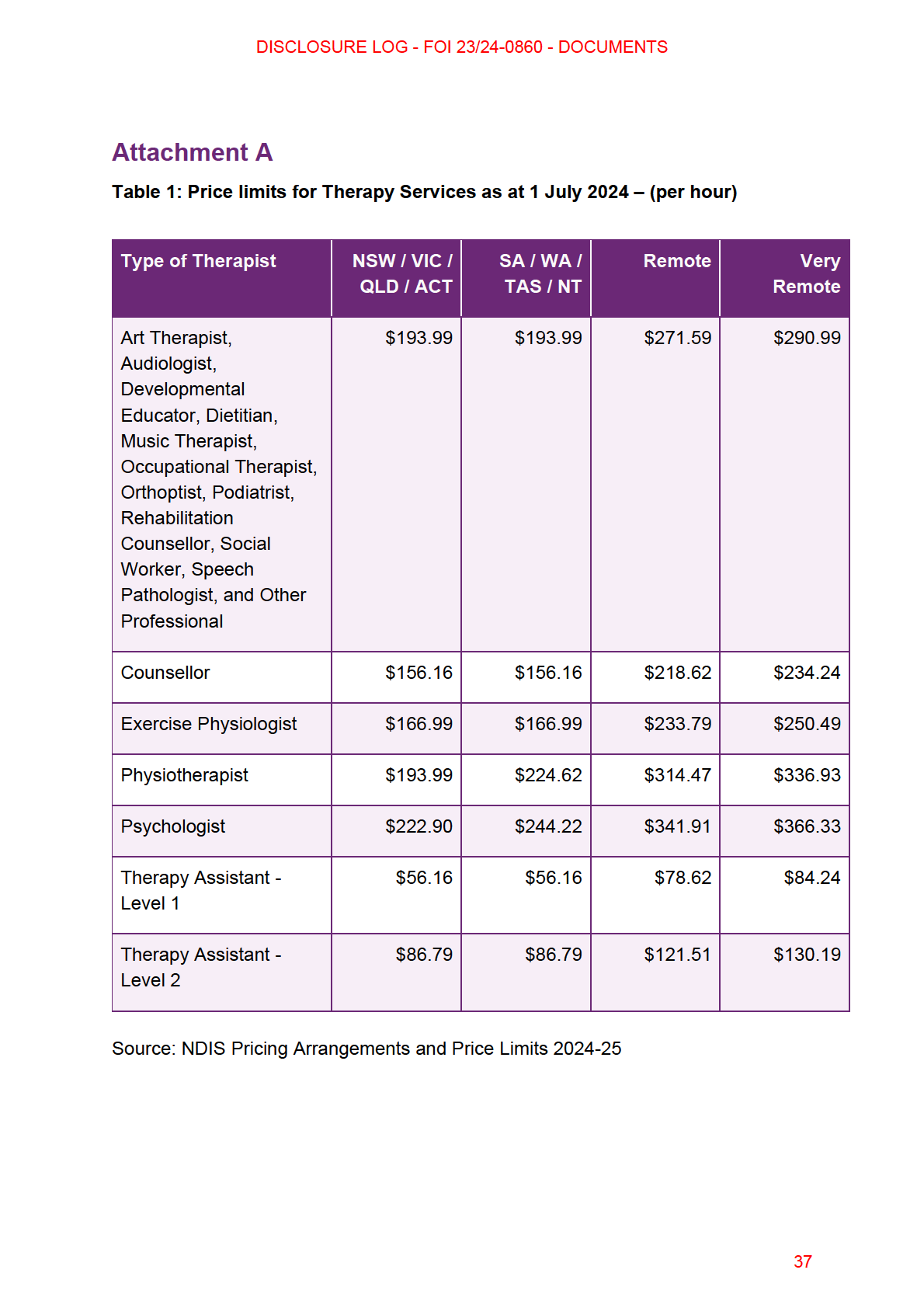
DISCLOSURE LOG - FOI 23/24-0860 - DOCUMENTS
National Disability Insurance Agency
ndis.gov.au
Telephone 1800 800 110
Webchat ndis.gov.au
Follow us on our social channels
Facebook, Twitter, Instagram, YouTube, LinkedIn
For people who need help with English
TIS: 131 450
For people who are deaf or hard of hearing
TTY: 1800 555 677
Voice relay: 1800 555 727
National Relay Service: relayservice.gov.au
38
DISCLOSURE LOG - FOI 23/24-0860 - DOCUMENTS
DOCUMENT 3
Documents referenced in evidence summary – FOI 24.25-0854
Aalbers, S., L. Fusar-Poli, R. E. Freeman, M. Spreen, J. C. Ket, A. C. Vink, A. Maratos, M.
Crawford, X. J. Chen and C. Gold (2017). "Music therapy for depression." Cochrane
Database Syst Rev
11(11): Cd004517.
Barnish, J., R. A. Atkinson, S. M. Barran and M. S. Barnish (2016). "Potential Benefit of
Singing for People with Parkinson's Disease: A Systematic Review." J Parkinsons Dis
6(3):
473-484.
Barnish, M. S. and S. M. Barran (2020). "A systematic review of active group-based dance,
singing, music therapy and theatrical interventions for quality of life, functional
communication, speech, motor function and cognitive status in people with Parkinson's
disease." BMC Neurol
20(1): 371.
Barnish, M. S. and R. V. Nelson-Horne (2023). "Group-based active artistic interventions for
adults with primary anxiety and depression: a systematic review." BMJ Open
13(6):
e069310.
Belski, N., Z. Abdul-Rahman, E. Youn, V. Balasundaram and D. Diep (2022). "Review: The
effectiveness of musical therapy in improving depression and anxiety symptoms among
children and adolescents - a systematic review." Child Adolesc Ment Health
27(4): 369-377.
Brackney, D. E. and J. L. Brooks (2018). "Complementary and Alternative Medicine: The
Mozart Effect on Childhood Epilepsy—A Systematic Review." The Journal of school nursing
34(1): 28-37.
Cohen-Yatziv, L. and D. Regev (2019). "The effectiveness and contribution of art therapy
work with children in 2018 -what progress has been made so far? A systematic review."
International Journal of Art Therapy
24(3): 100-112.
Crawford, M. J. and S. Patterson (2007). "Arts therapies for people with schizophrenia: an
emerging evidence base."
10: 69-70.
Geretsegger, M., L. Fusar-Poli, C. Elefant, K. A. Mössler, G. Vitale and C. Gold (2022).
"Music therapy for autistic people." Cochrane Database Syst Rev
5(5): Cd004381.
Geretsegger, M., K. A. Mössler, Ł. Bieleninik, X. J. Chen, T. O. Heldal and C. Gold (2017).
"Music therapy for people with schizophrenia and schizophrenia-like disorders." Cochrane
Database Syst Rev
5(5): Cd004025.
Kong, L., X. Zhang, L. Meng, H. Xue, W. Zhou, X. Meng, Q. Zhang and J. Shen (2023).
"Effects of music therapy intervention on gait disorders in persons with multiple sclerosis: A
systematic review of clinical trials." Mult Scler Relat Disord
73: 104629.
Lee, H. and B. Ko (2023). "Effects of Music-Based Interventions on Motor and Non-Motor
Symptoms in Patients with Parkinson's Disease: A Systematic Review and Meta-Analysis."
Int J Environ Res Public Health
20(2).
Lopes, J. and Keppers, II (2021). "Music-based therapy in rehabilitation of people with
multiple sclerosis: a systematic review of clinical trials." Arq Neuropsiquiatr
79(6): 527-535.
Lorenc, T., M. Rodgers, D. Marshall, H. Melton, R. Rees, K. Wright and A. Sowden (2018).
"Support for adults with autism spectrum disorder without intellectual impairment: Systematic
review." Autism
22(6): 654-668.
39
DISCLOSURE LOG - FOI 23/24-0860 - DOCUMENTS
Lutgens, D., G. Gariepy and A. Malla (2017). "Psychological and psychosocial interventions
for negative symptoms in psychosis: systematic review and meta-analysis." Br J Psychiatry
210(5): 324-332.
Ma, Y. M., M. D. Yuan and B. L. Zhong (2024). "Efficacy and acceptability of music therapy
for post-traumatic stress disorder: a systematic review and meta-analysis of randomized
controlled trials." Eur J Psychotraumatol
15(1): 2342739.
Maddox, G. A., G. E. Bodner, M. W. Christian and P. Williamson (2024). "On the
Effectiveness of Visual Arts Therapy for Traumatic Experiences: A Systematic Review and
Meta-Analysis." Clin Psychol Psychother
31(4): e3041.
Moumdjian, L., T. Sarkamo, C. Leone, M. Leman and P. Feys (2017). "Effectiveness of
music-based interventions on motricity or cognitive functioning in neurological populations: a
systematic review." Eur J Phys Rehabil Med
53(3): 466-482.
Newland, P. and B. A. Bettencourt (2020). "Effectiveness of mindfulness-based art therapy
for symptoms of anxiety, depression, and fatigue: A systematic review and meta-analysis."
Complement Ther Clin Pract
41: 101246.
Pedra Cruz Bettin, B., L. Urquiza Nogueira, P. A. Bertasso de Araujo and L. C. Antunes
(2024). "Visual art- and music-based interventions as adjuvants in the treatment of eating
disorders: a systematic review and a theoretical model." Arts Health
16(2): 167-188.
Regev, D. and L. Cohen-Yatziv (2018). "Effectiveness of Art Therapy With Adult Clients in
2018-What Progress Has Been Made?" Front Psychol
9: 1531.
Senkal, O. and Z. Muhtar (2021). "Role of orff music therapy in improving auditory
processing skills in children with intellectual disability." Nigerian journal of clinical practice
24(7): 1005-1014.
Uttley, L., M. Stevenson, A. Scope, A. Rawdin and A. Sutton (2015). "The clinical and cost
effectiveness of group art therapy for people with non-psychotic mental health disorders: a
systematic review and cost-effectiveness analysis." BMC Psychiatry
15: 151.
Vogel, S. W., K. L. Mullins and S. Kumar (2024). "Art therapy for children and adolescents
with autism: a systematic review." International Journal of Art Therapy: 1-10.
Wang, M., J. Wu and H. Yan (2023). "Effect of music therapy on older adults with
depression: A systematic review and meta-analysis." Complement Ther Clin Pract
53:
101809.
Weitlauf, A. S., N. Sathe, M. L. McPheeters and Z. E. Warren (2017). "Interventions
Targeting Sensory Challenges in Autism Spectrum Disorder: A Systematic Review."
Pediatrics
139(6): 1.
Yang, Y., Y. Y. Fang, J. Gao and G. L. Geng (2019). "Effects of Five-Element Music on
Language Recovery in Patients with Poststroke Aphasia: A Systematic Review and Meta-
Analysis." J Altern Complement Med
25(10): 993-1004.
Zhang, S., D. Liu, D. Ye, H. Li and F. Chen (2017). "Can music-based movement therapy
improve motor dysfunction in patients with Parkinson's disease? Systematic review and
meta-analysis." Neurol Sci
38(9): 1629-1636.
40
DISCLOSURE LOG - FOI 23/24-0860 - DOCUMENTS
Zhang, Y., J. Cai, Y. Zhang, T. Ren, M. Zhao and Q. Zhao (2016). "Improvement in Stroke-
induced Motor Dysfunction by Music-supported Therapy: A Systematic Review and Meta-
analysis." Sci Rep
6: 38521.
Zhou, Z., R. Zhou, W. Wei, R. Luan and K. Li (2021). "Effects of music-based movement
therapy on motor function, balance, gait, mental health, and quality of life for patients with
Parkinson's disease: A systematic review and meta-analysis." Clin Rehabil
35(7): 937-951.
41



















